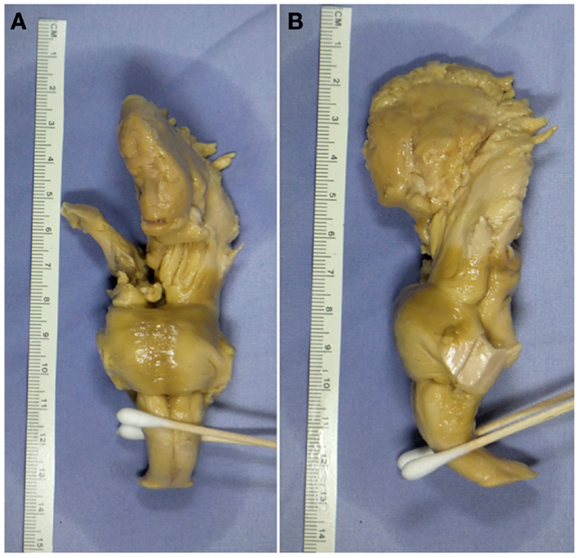|
Bahija Jallal
Bahija Jallal (born May 8, 1961) is chief executive officer and director of the board of Immunocore. She has previously been president at MedImmune and AstraZeneca. She is a council member of the Government–University–Industry Research Roundtable of the National Academies of Sciences, Engineering and Medicine. Early life and education Jallal grew up in Morocco. She was one of six children, and her mother raised them alone because her father died at an early age. She became interested in science, first earning doctorate studies in physiology at the Université de Paris VI. She was a postdoctoral researcher in molecular biology and oncology at the Max Planck Institute for Biochemistry. Research and care Jallal moved to the United States and moved into the biotechnology industry. She first joined SUGEN, where she worked on small-molecule anticancer kinase inhibitors. In the early 2000s she started working on monoclonal antibodies, at Chiron Corporation and MedImmune. At Ch ... [...More Info...] [...Related Items...] OR: [Wikipedia] [Google] [Baidu] |
The Life Scientific
''The Life Scientific'' is a BBC Radio 4 science programme, presented by Jim Al-Khalili, in which each episode is dedicated to the biography and work of a living scientist. The programme consists of an interview between Al-Khalili and the featured scientist, with others contributing anecdotes. It is broadcast on Tuesday mornings in the UK, and is available online and via BBC Sounds, as is an archive of past episodes. In October 2021 the programme reached its 10-year anniversary with discussion between Ottoline Leyser, Paul Nurse, Christopher Jackson (geologist), Christopher Jackson and Sue Black (computer scientist), Sue Black on the topic of 'What makes a scientist?'. Guests Guests have included: References External links * {{DEFAULTSORT:Life Scientific BBC Radio 4 programmes Science radio programs 2011 radio programme debuts ... [...More Info...] [...Related Items...] OR: [Wikipedia] [Google] [Baidu] |
Université De Paris VI
Pierre and Marie Curie University ( , UPMC), also known as Paris VI, was a public research university in Paris, France, from 1971 to 2017. The university was located on the Jussieu Campus in the Latin Quarter of the 5th arrondissement of Paris, France. UPMC merged with Paris-Sorbonne University into a new combined Sorbonne University. History Paris VI was one of the inheritors of the faculty of Sciences of the University of Paris, which was divided into several universities in 1970 after the student protests of May 1968. In 1971, the five faculties of the former University of Paris (Paris VI as the Faculty of Sciences) were split and then re-formed into thirteen universities by the Faure Law. The campus of Paris VI was built in the 1950s and 1960s, on a site previously occupied by wine storehouses. The Dean, Marc Zamanski, saw the Jussieu campus standing as a tangible symbol of scientific thought in the heart of Paris, with the Faculty of Science, set in the Latin Quarter, as ... [...More Info...] [...Related Items...] OR: [Wikipedia] [Google] [Baidu] |
Ex Vivo
refers to biological studies involving tissues, organs, or cells maintained outside their native organism under controlled laboratory conditions. By carefully managing factors such as temperature, oxygenation, nutrient delivery, and perfusing a nutrient solution through the tissue's vasculature, researchers sustain function long enough to conduct experiments that would be difficult or unethical in a living body. ''Exvivo'' models occupy a middle ground between '' in vitro'' () models, which typically use isolated cells, and '' in vivo'' () studies conducted inside living organisms, offering both experimental control and physiological relevance. ''Ex vivo'' platforms support pharmacologic screening, toxicology testing, transplant evaluation, developmental biology, and investigations of disease-mechanism research across medicine and biology, from cardiology and neuroscience to dermatology and orthopedics. Because they often use human tissues obtained from clinical ... [...More Info...] [...Related Items...] OR: [Wikipedia] [Google] [Baidu] |
Living People
Purpose: Because living persons may suffer personal harm from inappropriate information, we should watch their articles carefully. By adding an article to this category, it marks them with a notice about sources whenever someone tries to edit them, to remind them of WP:BLP (biographies of living persons) policy that these articles must maintain a neutral point of view, maintain factual accuracy, and be properly sourced. Recent changes to these articles are listed on Special:RecentChangesLinked/Living people. Organization: This category should not be sub-categorized. Entries are generally sorted by family name In many societies, a surname, family name, or last name is the mostly hereditary portion of one's personal name that indicates one's family. It is typically combined with a given name to form the full name of a person, although several give .... Maintenance: Individuals of advanced age (over 90), for whom there has been no new documentation in the last ten ... [...More Info...] [...Related Items...] OR: [Wikipedia] [Google] [Baidu] |
Moroccan Women
Moroccan may refer to: * Something or someone from, or related to the country of Morocco ** Moroccans, or Moroccan people ** Moroccan Arabic, spoken in Morocco ** Moroccan Jews See also * Morocco leather Morocco leather (also known as Levant, the French Maroquin, Turkey, or German Saffian from Safi, a Moroccan town famous for leather) is a vegetable-tanned leather known for its softness, pliability, and ability to take color. It has been widely ... * * {{disambig Language and nationality disambiguation pages ... [...More Info...] [...Related Items...] OR: [Wikipedia] [Google] [Baidu] |
Healthcare Businesswomen's Association
The Healthcare Businesswomen's Association (HBA) was founded in 1977 as a global non-profit organization with the stated goal of furthering women involvement in healthcare worldwide. It’s currently headquartered in New Jersey, United States, and as of 2021, it had 9,537 members worldwide. Organizational structure The current CEO of the HBA is Mary Stutts. Press The HBA has been featured on CIO.com, ''Associations Now'' magazine, BlogTalkRadio BlogTalkRadio was a web-based platform that allowed podcasters and radio sites and talk show hosts to create live and on-demand talk format content for distribution on the web and podcast distribution channels. It offered a web-based 'studio' tha ..., and the PharmaVOICE Podcast. References {{reflist External linksOfficial site Professional associations based in the United States Organizations established in 1977 ... [...More Info...] [...Related Items...] OR: [Wikipedia] [Google] [Baidu] |
Jim Al-Khalili
Jameel Sadik "Jim" Al-Khalili (; born 20 September 1962) is an Iraqi-British theoretical physicist and science populariser. He is professor of theoretical physics and chair in the public engagement in science at the University of Surrey. He is a regular broadcaster and presenter of science programmes on BBC radio and television, and a frequent commentator about science in other British media. In 2014 Al-Khalili was named as a RISE (Recognising Inspirational Scientists and Engineers) leader by the UK's Engineering and Physical Sciences Research Council (EPSRC). He was President of Humanists UK between January 2013 and January 2016. Early life and education Al-Khalili was born in Baghdad in 1962. His father was an Iraqi Air Force engineer, and his English mother was a librarian. Al-Khalili settled permanently in the United Kingdom in 1979. After completing (and retaking) his A-levels over three years until 1982, he studied physics at the University of Surrey and graduated wi ... [...More Info...] [...Related Items...] OR: [Wikipedia] [Google] [Baidu] |
Autoimmune Disease
An autoimmune disease is a condition that results from an anomalous response of the adaptive immune system, wherein it mistakenly targets and attacks healthy, functioning parts of the body as if they were foreign organisms. It is estimated that there are more than 80 recognized autoimmune diseases, with recent scientific evidence suggesting the existence of potentially more than 100 distinct conditions. Nearly any body part can be involved. Autoimmune diseases are a separate class from autoinflammatory diseases. Both are characterized by an immune system malfunction which may cause similar symptoms, such as rash, swelling, or fatigue, but the cardinal cause or mechanism of the diseases is different. A key difference is a malfunction of the innate immune system in autoinflammatory diseases, whereas in autoimmune diseases there is a malfunction of the adaptive immune system. Symptoms of autoimmune diseases can significantly vary, primarily based on the specific type of the d ... [...More Info...] [...Related Items...] OR: [Wikipedia] [Google] [Baidu] |
Escherichia Coli
''Escherichia coli'' ( )Wells, J. C. (2000) Longman Pronunciation Dictionary. Harlow ngland Pearson Education Ltd. is a gram-negative, facultative anaerobic, rod-shaped, coliform bacterium of the genus '' Escherichia'' that is commonly found in the lower intestine of warm-blooded organisms. Most ''E. coli'' strains are part of the normal microbiota of the gut, where they constitute about 0.1%, along with other facultative anaerobes. These bacteria are mostly harmless or even beneficial to humans. For example, some strains of ''E. coli'' benefit their hosts by producing vitamin K2 or by preventing the colonization of the intestine by harmful pathogenic bacteria. These mutually beneficial relationships between ''E. coli'' and humans are a type of mutualistic biological relationship—where both the humans and the ''E. coli'' are benefitting each other. ''E. coli'' is expelled into the environment within fecal matter. The bacterium grows massi ... [...More Info...] [...Related Items...] OR: [Wikipedia] [Google] [Baidu] |
CD3 (immunology)
CD3 ( cluster of differentiation 3) is a protein complex and T cell co-receptor that is involved in activating both the cytotoxic T cell (CD8+ naive T cells) and T helper cells (CD4+ naive T cells). It is composed of four distinct chains. In mammals, the complex contains a CD3γ chain, a CD3δ chain, and two CD3ε chains. These chains associate with the T-cell receptor (TCR) and the CD3-zeta (ζ-chain) to generate an activation signal in T lymphocytes. The TCR, CD3-zeta, and the other CD3 molecules together constitute the TCR complex. Structure The CD3γ, CD3δ, and CD3ε chains are highly related cell-surface proteins of the immunoglobulin superfamily containing a single extracellular immunoglobulin domain. A structure of the extracellular and transmembrane regions of the CD3γε/CD3δε/CD3ζζ/TCRαβ complex was solved with CryoEM, showing for the first time how the CD3 transmembrane regions enclose the TCR transmembrane regions in an open barrel. Containing ... [...More Info...] [...Related Items...] OR: [Wikipedia] [Google] [Baidu] |
Anti-CD3 Monoclonal Antibody
An anti-CD3 monoclonal antibody is one that binds to CD3 on the surface of T cells. They are immunosuppresive drugs. The first to be approved was muromonab-CD3 in 1986, to treat transplant rejection. Newer monoclonal antibodies with the same mechanism of action include otelixizumab, teplizumab and visilizumab. They are being investigated for the treatment of other conditions like Crohn's disease, ulcerative colitis and type 1 diabetes, and for inducing immune tolerance. Mechanism of action See muromonab-CD3. See also * List of monoclonal antibodies Therapeutic, diagnostic and preventive monoclonal antibodies are clones of a single parent cell. When used as drugs, the International Nonproprietary Names (INNs) end in -mab. The remaining syllables of the INNs, as well as the column ''Source'', ... References Monoclonal antibodies {{antineoplastic-drug-stub ... [...More Info...] [...Related Items...] OR: [Wikipedia] [Google] [Baidu] |
Biologics
A biopharmaceutical, also known as a biological medical product, or biologic, is any pharmaceutical drug product manufactured in, extracted from, or semisynthesized from biological sources. Different from totally synthesized pharmaceuticals, they include vaccines, whole blood, blood components, allergenics, somatic cells, gene therapies, tissues, recombinant therapeutic protein, and living medicines used in cell therapy. Biopharmaceuticals can be composed of sugars, proteins, nucleic acids, or complex combinations of these substances, or may be living cells or tissues. They (or their precursors or components) are isolated from living sources—human, animal, plant, fungal, or microbial. They can be used in both human and animal medicine. Terminology surrounding biopharmaceuticals varies between groups and entities, with different terms referring to different subsets of therapeutics within the general biopharmaceutical category. The term biologics is often used more restric ... [...More Info...] [...Related Items...] OR: [Wikipedia] [Google] [Baidu] |



